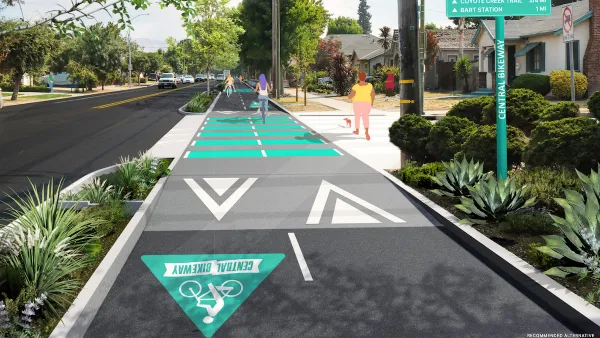The successes and failures of past pedestrian malls can inform the future of pandemic-induced "open streets" programs.

The COVID-19 pandemic, writes Stephan Schmidt, emphasized the importance of public, outdoor space as cities around the world opened previously car-centric streets to pedestrians and reimagined street space as more than a way to move cars from place to place. "Alternatively referred to as slow, open, shared or active streets, many of these pandemic-inspired closures were successful, and several cities opted to continue these street changes over the course of the summer."
Now, "as summer ends and cities continue to reopen, local officials will need to decide whether to revert to the status quo or make the often-popular pedestrianized corridors permanent."
Describing the history of American pedestrian malls and their rise and fall during the 1960s through 1990s, Stephan Schmidt draws comparisons to today's pandemic streets, taking lessons from the successes and failures of the past to inform our current car-free projects. Cities, Schmidt writes, can "utilize design interventions to create more desirable pedestrian environments" and support car-free areas.
Based on his research, Schmidt describes four elements of successful pedestrian malls. These include "creating a sense of enclosure and requiring the use of ground-floor windows to increase transparency," protection from weather and varied seating options, visual appeal created through landscaping, and programmed activities. He also recommends that pedestrian malls seek connections with adjacent properties to reduce a feeling of isolation and increase pedestrian traffic.
"Many downtowns and central business districts now have more full-time residents than they did in decades past, a density boost that bodes well for this new wave of shared streets. Officials must weigh many factors as they bring their urban centers back to 'normal,' but they should remember that, for many, normal means experiencing the city via a car-free public space."
FULL STORY: Lessons From the Rise and Fall of the Pedestrian Mall

Planetizen Federal Action Tracker
A weekly monitor of how Trump’s orders and actions are impacting planners and planning in America.

In Praise of Analog Cities: Futureproofing in a Time of Crisis
I didn’t need a pandemic or a war to teach me that smart cities weren’t the future — but it sure drove the message home.

Silicon Valley ‘Bike Superhighway’ Awarded $14M State Grant
A Caltrans grant brings the 10-mile Central Bikeway project connecting Santa Clara and East San Jose closer to fruition.

A Vision for the Future: LA County Releases Draft Sustainability Plan
Los Angeles County has released the draft 2025 OurCounty Sustainability Plan — shaped by community input — and is inviting public feedback through August 22 to help guide the County’s path toward a more sustainable, equitable, and resilient future.

Honoring Elders: California Tribe Breaks Ground on Affordable Housing
The Fernandeño Tataviam Band of Mission Indians is launching its first senior housing project in Los Angeles County, creating 26 affordable units to serve Native elders and address longstanding housing inequities.

Which San Diego County Cities Are Building New Housing?
Chula Vista permitted the most new housing units per capita, while El Cajon is adding the least.
Urban Design for Planners 1: Software Tools
This six-course series explores essential urban design concepts using open source software and equips planners with the tools they need to participate fully in the urban design process.
Planning for Universal Design
Learn the tools for implementing Universal Design in planning regulations.
Heyer Gruel & Associates PA
Yukon Government
New Jersey Institute of Technology
Mpact (founded as Rail~Volution)
City of Camden Redevelopment Agency
City of Norman, Oklahoma
City of Portland
City of Laramie





























